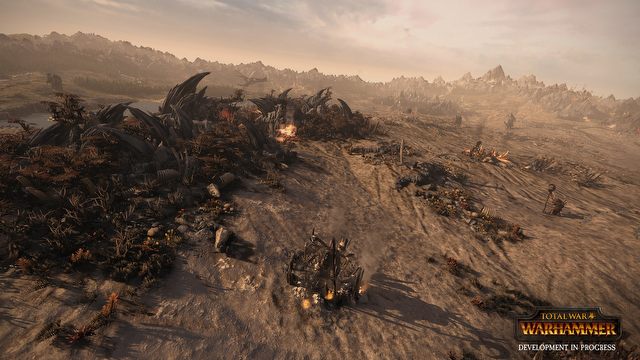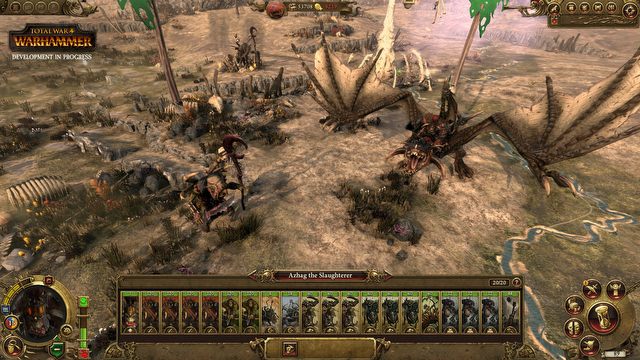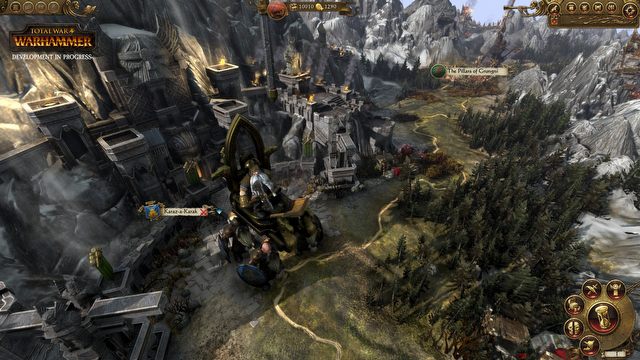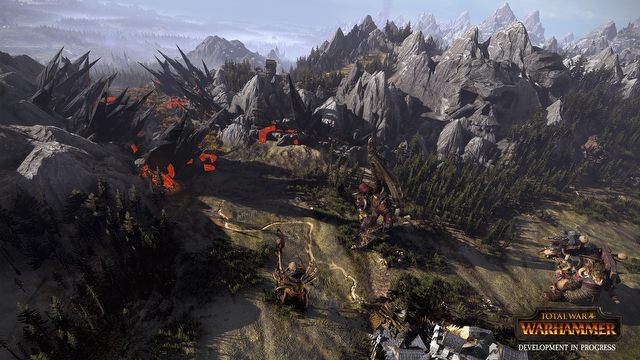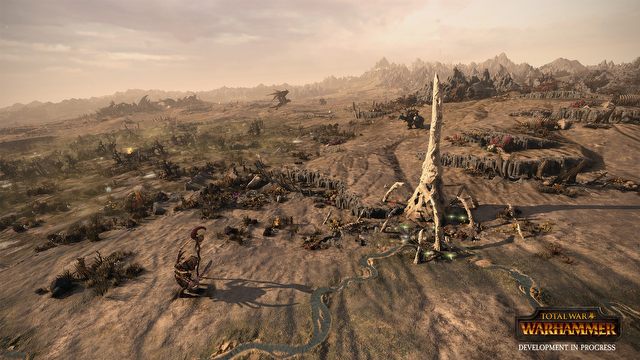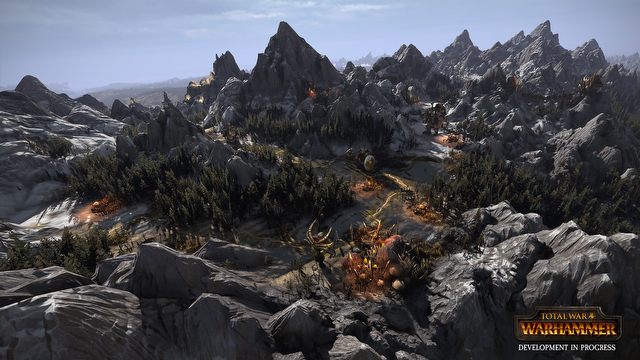First Look at Total War: Warhammer campaign map
Another mystery of Total War: Warhammer is no more - we saw orc gameplay on campaign map.
Total War: Warhammer is going to launch in April 2016, which is less than in five months – and yet this extremely promising strategy game from Creative Assembly still holds many mysteries. Thankfully, the developers recently revealed the game’s biggest secret – the campaign map. During the last couple of months we watched lots of spectacular battles between Dwarves, Greenskins, and the Empire of Man, but now we got a peek into the other fundamental gameplay layer – turn-based kingdom management. Although we didn’t get a chance to actually have our hands on the game, take command of armies and agents, expand cities, develop technologies, and so on, a half an hour long presentation was enough to get a first impression. What made the demonstration even more exciting was the fact that it featured a very interesting race in terms of gameplay – the Greenskins.
Let’s start by briefly summarizing overall gameplay mechanics. Just as in previous Total War games, you get to look at the world from two perspectives: a small-scale 2D map of the entire game area and a close-up 3D view prevailing in battles. Warhammer is still in its Alpha, so in terms of technology, the game looks similar to what we saw in Rome II, but the overall impression is that Warhammer is much more enchanting. This is because of the transition into a fantasy universe. The Old World is filled with breathtaking landscapes and details that build up great atmosphere: dwarven fortresses raised in the mountains, wastelands dotted by bonfires and skewed orkish banners, Winds of Magic floating here and there, occasional ruins, as well as heroes and beasts of different races. More importantly, the game area is vast and really diverse. As expected, Creative Assembly is going to offer almost the entire Old World right from the start – from the icy Norsca and Chaos Wastes in the north across to Tilea and desolate Badlands in the south, and from the green coasts of Estalia and Bretonnia in the west to the soaring World’s Edge Mountains in the east.
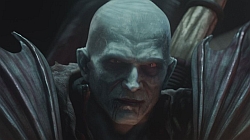
Creative Assembly still hasn’t shared too many materials on Men, Dwarves, and Greenskins, or even the forces of Chaos, but they revealed almost nothing about the undead Sylvani, commanded by the Vampire Lords. The campaign map presentation didn’t change much on the matter, however - in the overview of the Old World we could see some representatives of that race as well as a strip of land defiled by the undead.
First thing you do when you start playing is choosing the leader of your faction – a so-called Legendary Lord. Each faction will most likely have three leaders; as for the Greenskins, the two revealed so far are Grmigor Ironhide and Azhag the Slaughterer. Both gentlemen are orkish leaders with unique skills. These differences between them become more evident in time as the heroes complete their own mission trees and unlock several unique assets – artifacts, mounts, etc (all this is described in the character progression menu). For instance, Azhag, the one chosen for the presentation, can come into possession of a magic crown that unlocks a whole new skill tree of dark magic. He can also obtain a dreadful wyvern and gain the ability to fly around the campaign map (which obviously creates a whole lot of new tactical possibilities). The creators also showed us a final part of a quest for a powerful weapon – interestingly, the struggle to get the artifact is concluded with a battle against humans in the Black Fire Pass (the one showed off in the first gameplay video released a couple of months ago), analogically to the Emperor Karl Franz’s missions, whose goal is to obtain a legendary war hammer Ghal Maraz.
In case of orcs and goblins gameplay is built on all the key mechanics that we know from previous Total War games: recruiting and moving armies, territorial expansion, conquering and expanding cities, managing your territories, technological development, progression of heroes (both aforementioned leaders and ‘ordinary’ agents), etc. If you played previous games in the series, you should get acquainted with the mechanics in no time; even menus look familiar (although many of them, e.g. the building menu, they have more clear descriptions). Differences between factions in Warhammer will be much bigger than in other games in the Creative Assembly’s flag game series – both in terms of types and quantity of available options. For example, the concepts of culture, economy or social politics are foreign to the Greenskins – only war really matters to them, so their buildings, technologies, and abilities focus almost entirely on warfare – all in all, they have less development options than other factions.
This, however, does not mean that commanding this faction is simple and uncomplicated – orcs and goblins have lots of features designed to make the experience deep and meaningful. By far, the most essential indicator for the Greenskins is the fighting spirit. Your job is to keep your armies fighting and winning. This fills a special bar, and when it’s full, the faction enters into a “Waaagh!” status. This spawns a strong allied army on the map, whom you are able to send against a selected target (although you don’t get direct control over it). If, however, you leave the army be, the orcs and goblins will start fighting each other out of boredom, an in effect their morale and supplies will be gradually dropping. So if there are no enemies nearby, you may want to slow down that process by immobilizing the army, that is setting up a raiding camp (a new stance). Another feature unique for the Greenskins is the ability to recruit warriors nearly everywhere – you do not have to visit a city to that end; however, field recruitment is done at a higher cost.
A small though interesting addition to battle mechanics are banners. They are sorts of artifacts that can be assigned to selected troops in order to increase their statistics. There are both banners that are ascribed to particular factions and those common to all races.
As we already know, the base game will feature four playable factions: Humans, Greenskins, Dwarves, and the Undead (theoretically, there are also the forces of Chaos – more on that in a moment). Looking at the sheer sizes of the Old World’s map it’s easy to guess these are not the only residents of the Warhammer universe. As for now, other factions, including Wood Elves, Knights of Bretonnia, Corsairs of Norsca, and the Tilean Condottiere, are AI-controlled, making up potential allies or trade partners. Most of them is likely to become playable in time – through paid or free DLCs – but the developers have no clear plans about that yet (just like they’re not sure if the second part of the Total War: Warhammer trilogy is coming in 2017 or later). We should also mention the role of water regions in gameplay. Unfortunately, we won’t witness any sea battles (they will be resolved automatically), so any bodies of water will most likely be used only as traffic routes. To confirm that Creative Assembly showed off a dwarven steamship in the Black Gulf (settled on the south of the Old World).
This basically wraps up the materials that Creative Assembly showed the press during the latest presentation, but we feel we should mention one other piece of news that emerged online in the last couple of weeks. We finally found out what the much anticipated forces of Chaos will actually be present. This, however, is a big fat fly in the ointment Total War: Warhammer appears to be. The destructive forces whose only goal is to annihilate all life in the Old World will only be playable for those players who pre-order the title – later this will probably become available as a paid DLC. Of course, incentives in the form of pre-order bonuses are nothing new, but when it comes to expanding the game by almost 1/4 – and we’re talking about one of the key factions of the Old World – it rightfully rises concerns. This is the more painful as Chaos is a really exciting faction with dozens of original heroes and units and intriguing gameplay mechanics – it focuses on preparing armies for long raids and fast conquest (troops are almost immune to exhaustion and they can set up posts anywhere), pillaging lands and spreading the cult of the Chaos Gods in order to sabotage other factions.

A few days ago Creative Assembly revealed more about another playable faction – the Empire of Man. As previously announced, this faction will offer gameplay model that is the closest to what we know from previous Total War games. Their armies include a wide spectrum of units designed for sworn strategists, although the main role will be played by artillery and cavalry. If you pick up the Empire, first thing you need to do is unite the individual provinces, and at some point you will have to face the invasion of Chaos. There will be 2 Legendary Lords, 6 hero classes and 5 mounts in the Empire, as well as 18 types of units.
To sum up, I can only repeat what many have been saying about Total War: Warhammer since its reveal – the game is extremely promising. What we saw this far makes us almost certain that the game gets the right feel of the Old World and offers deep, working game mechanics. There are only two, yet important worries. First, after many problems players experienced with Total War: Rome II we have all the reason to fear that Warhammer too will be troubled by many issues. Although Creative Assembly assures they learned a lot since the second Rome, the concern remains.
Second, the pre-ordering politics really seem to be a rip-off. We’d like to hope Creative Assembly and SEGA won’t be so aggressive about future DLCs, but that seems unlikely. We just hope that free DLCs will be as fat as paid content. However, the developers resolve these matters, one thing seems certain – Total War: Warhammer has everything it takes to become the best strategy (and maybe even the best video game in general) set in the Old World. We hope that the problems that lay outside the core gameplay won’t cast a shadow over the game as a whole.
